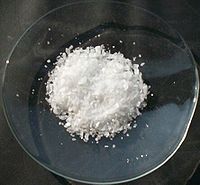
Photo from wikipedia
Abstract Boron (B) is highly mobile in the environment. This characteristic easily leads to plant deficiency upon leaching from soil or to toxicity upon accumulation. Boric acid may interact with… Click to show full abstract
Abstract Boron (B) is highly mobile in the environment. This characteristic easily leads to plant deficiency upon leaching from soil or to toxicity upon accumulation. Boric acid may interact with mineral surfaces as well as natural organic matter. In this study, the boric acid interaction with humic acid (HA) was measured in 0.01 M NaCl and CaCl2 background solutions as a function of pH and the initial B concentration. In the Na-HA suspensions, the free boric acid concentration was determined using a novel approach, applying the Donnan Membrane Technique (DMT) in the dynamic mode. In the method, the experimental rate of diffusion is used as a measure for the free boric acid concentration. B adsorption in Na-HA and Ca-HA systems can be described with the NICA-Donnan model using a single set of boron binding parameters. In Na-HA systems, the adsorption of boric acid strongly increases with the background electrolyte concentration, due to a better screening of the HA charge. In this respect, the adsorption behavior of boric acid is opposite to that of heavy metal ions. Modeling shows that the boric acid adsorption is determined by the competition of H+, Ca2+, and B(OH)3 at binding to the sites of HA. The parameterized NICA-Donnan model is well able to predict the pH-dependent adsorption of boric acid in soil organic horizons. The model is a promising tool for future predictions of the fate of boric acid in a variety of natural multicomponent environments, including soil and seawater.
Journal Title: Chemical Geology
Year Published: 2019
Link to full text (if available)
Share on Social Media: Sign Up to like & get
recommendations!